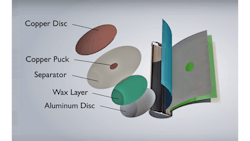Internal Short-Circuit Device Paves Way to Safer Li-Ion Battery Testing
The National Renewable Energy Lab (NREL) says its newly developed internal short-circuit (ISC) device should help improve the safety of lithium-ion batteries in space gear and electric-drive vehicles. The advance is, ironically, in response to the Li-ion battery’s inherent efficiency—its long life, high energy capacity, and rechargeability over thousands of cycles also make the battery prone to unexpected shorts that induce thermal runaway (see the figure). Thus, engineers are wary about having Li-ion batteries become the standard in electronic and hybrid vehicles. The NREL’s patented ISC assuages those fears by enabling reliable testing of the thermal-runaway effects of Li-ion-battery shorts.
The statistics for shorts occurring in Li-ion batteries is one to ten in a million, according to Matthew Keyser, NREL senior engineer. A short may be caused by an impurity in the battery, likely introduced in the manufacturing process. But the intensity of thermal runaway is far worse than in regular batteries, making Li-ion batteries effectively more dangerous than regular batteries.
Tests with NASA have produced reproducible and consistent results, allowing engineers to devise mechanisms that counteract thermal runaway or contain it in a single battery so that it doesn’t spread to the rest of the pack. Previous methods of testing short-circuit effects include piercing a battery with a nail or rod, crushing it, applying high voltage, or increasing its temperature. However, these methods are not consistent enough to validate the use in electric cars and space applications.
The ISC, on the other hand, is placed within the cell, acting as an internal thermal switch to produce all four types of shorts. In order from benign to severe, these include electrode to electrode, electrode to cathode, electrode to anode, and cathode to anode. This highly controlled method enables scientists to come up with more accurate and reproducible solutions.
The device is a small, layered disc constructed out of copper and aluminum with a copper pluck, a polyethylene or polypropylene separator, and a thin layer of wax. It is implanted in the cell and then exposed to a higher temperature to melt the thin wax layer. The remaining metal components then come into contact to induce an internal short while sensors record the cell’s reactions.
The NREL and NASA plan to use the device for spacesuit battery safety. Eventually, the NREL hopes to bring the ISC device into mass production, most importantly for testing of Li-ion batteries used in electric cars.
For information on licensing the NREL’s ISC device, contact Erin Beaumont at (303) 275-4353 or [email protected].
About the Author
Leah Scully
Associate Content Producer
Leah Scully is a graduate of The College of New Jersey. She has a BS degree in Biomedical Engineering with a mechanical specialization. Leah is responsible for Machine Design’s news items that cover industry trends, research, and applied science and engineering, along with product galleries. Visit her on Facebook, or view her profile on LinkedIn.

